A few weeks ago, I set off on an unusual journey. I would be joining what looked like a motorcycle gang headed into the Mid-Western Region of Nepal. Despite my time in the country, I’d never traveled further than Butwal, a city far from the Mid-Western Regions border. The mid-west seemed like a far off land. An ominous place that was out of reach to tourists and travelers. What brought me there was a project with Clean Drink Adventure (now Far Xplorer) and a promise to change people’s lives.
Nepal is known as a developing country. The more widely used, but less politically correct, term is that it’s a third world country. Regardless of semantics, the country lacks infrastructure and one of the major problems in rural areas is the ability to get clean water. Things that we take for granted every day are killing people in Nepal. Contaminated drinking water causes problems like severe diarrhea, typhoid, and dysentery. Without proper treatment, these diseases are deadly, especially in children. The scary thing is that they’re all preventable with something as simple as a water treatment system.
So, we set off into the unknown with the hopes of delivering 10 water systems which cost $250 apiece and require about $200 in supplies and follow-up visits. The thing is, we didn’t meet our goal. Instead, we exceeded it. We arrived at the village of Kaina Bazaar carrying 22 MSR SE200 chlorine makers. It took two days of driving on tiny dirt roads to arrive near the village. We were traveling by motorcycle and an off-roading jeep. At the bottom of a hill, on the last stretch of “highway,” we were told that the locals would like to greet us before entering the village. What came next was beyond anything we could have imagined.
We chugged along on the dirt road going uphill until we saw a small crowd of about 20 people. As we approached, it became clearer that several of the men were holding drums. They began to play a tribal beat that echoed in the river valley nearby. We waited for the song to end and clapped at the exciting greeting. “This is how they greet visitors to the village,” someone nearby said. Just when we thought it was time to move on, they began to play again, this time while walking slowly up the hill. The village wasn’t even in sight yet, but it appeared they would be playing the drums the entire way there.
As we continued slowly up the road, more and more villagers joined our parade. Small children looked at us curiously, and those of us riding bikes invited them on board. It seemed to be an unusual treat for them to be on the back of a motorcycle. After 10 minutes, we reached the top of a small hill and the village came into sight for the first time. I turned to Christophe, “It’s the entire village.” He looked at me confused, and I pointed in the distance to several houses tucked away in the hillside and turned back to him, “The whole village is waiting for us.”
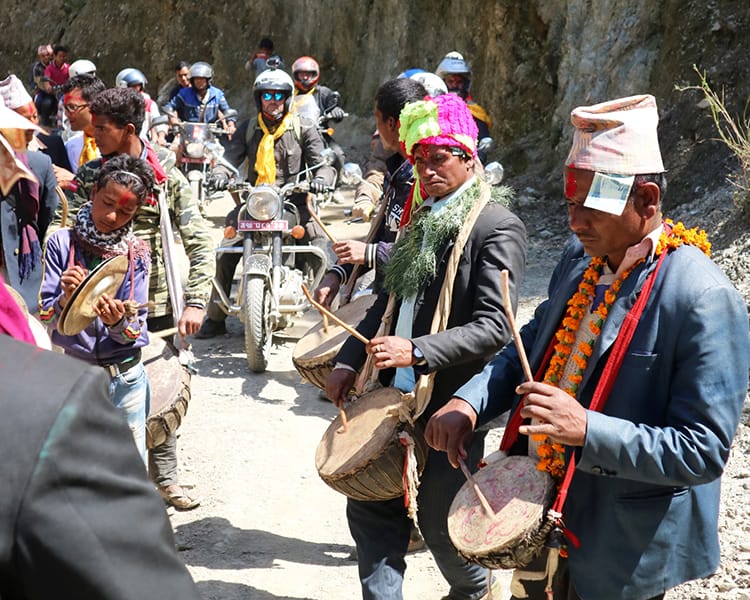
The drumline continued slowly towards the mass of people. The closer we got, the more people I could see. There were over 100 villagers. Perhaps more than 200. Their vibrant clothing formed a rainbow under the sunny sky. A stark contrast to the dull dusty road that lay behind us. We were instructed to get off the bikes and walk through the crowd. The sea of people parted in the center and suddenly women holding malas (handmade flower garlands) stepped forward into the space. An overwhelming sense of joy enveloped us as one person after another greeted us with a flower necklace and the traditional red tikka rubbed onto our foreheads. Tears formed in my eyes at the genuine happiness that pulled us in and surrounded us like a warm blanket.
We moved further into the crowd, the flower necklaces were getting so high around my neck that they almost reached my eyes making it hard to turn and look around me. I caught a glimpse of Christophe who was behind me with what appeared to be a beard made out of flowers. I reached for my camera around my neck to capture the moment, but it was buried under 10 lbs of fresh floral necklaces.
It didn’t escape me that this welcome wasn’t just for us. It was for every person who donated money, for each person who shared posts on social media, for everyone who planned the trip behind the scenes. This welcome was for them; we were just the ones lucky enough to accept it on their behalf. We moved through the crowd towards the end of the masses. Our hearts warmed by the hospitality and generosity of a people with so little to give.
And just when we thought it was over, we were moved to the village square where women sat in every available space. Their bright colored sarees covering the hills within the village walls. Small benches were moved close by, and we were seated at the front behind an MC with a mic speaking quickly in Nepali. An introduction for each of us was said followed by clapping, and then the school representatives who came to accept the water systems were announced. All 22 sat nearby ready to deliver hope to their own villages.

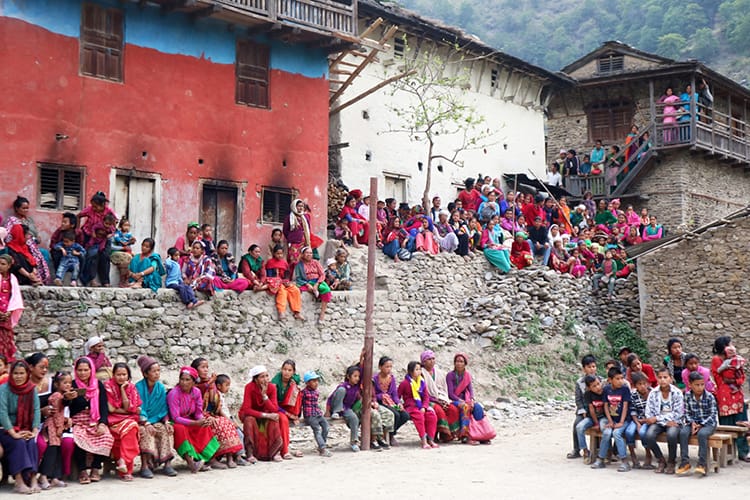
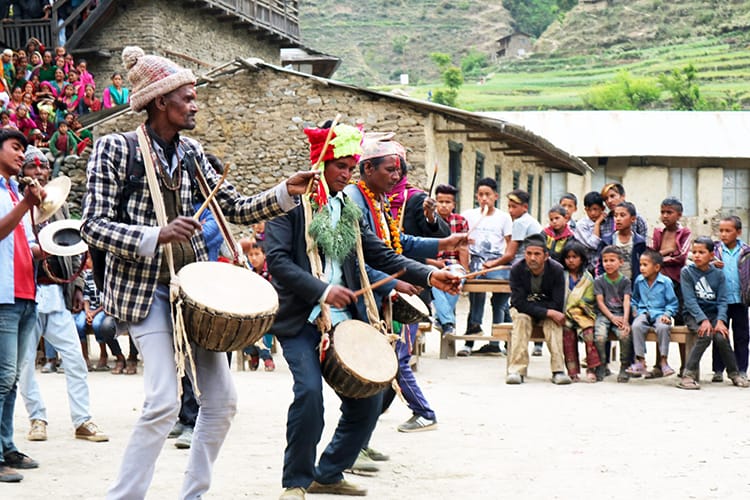
The drummers came into the center of the square and continued their elaborate welcome followed by dancers. The mix and variety of performances appeared to be from several different cultures, and we only learned later that they had reenacted their favorite festival for us as a thank you. At one point, a circle of women danced slowly while holding hands and singing a beautifully eerie song. The elder man sitting next to me said the word, “Nachnu.” I wished I hadn’t understood him, but I knew the translation was “dance.” He pointed to me, and then to the performance. To confirm my suspicions, I pointed to myself and then to the dancers and repeated the word, “Nachnu?” He smiled and nodded. As the only woman in our group, it had appeared that it was my job to dance.
I stood up slowly, and it felt as though everyone stopped to stare at me. I looked back at the old man.His giant smile and pointing hand seemed to refuse to take no for an answer. I walked slowly up to the woman who formed the circle and touched their hands lightly signaling that I wanted to join in. They looked at me stunned but welcomed me into their dance circle. I heard an outburst of laughter from every direction and immediately felt self-conscious. The woman to my right smiled and then looked down at her feet and exaggerated the steps for me so that I could follow. I fumbled around for a few minutes until I was able to get the beat down.

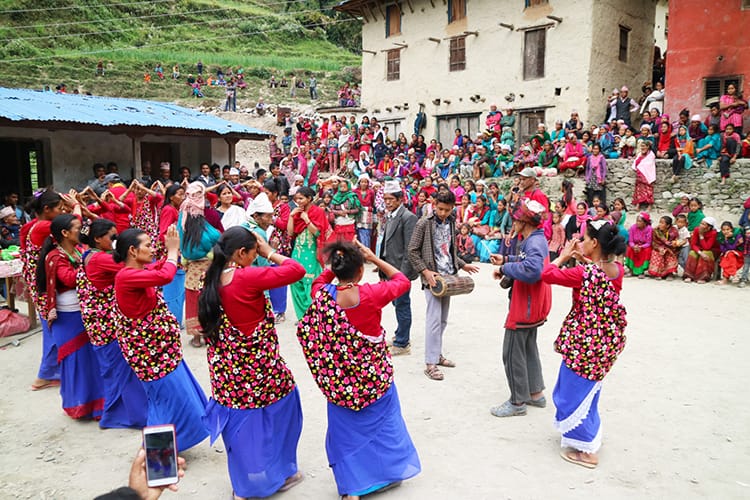
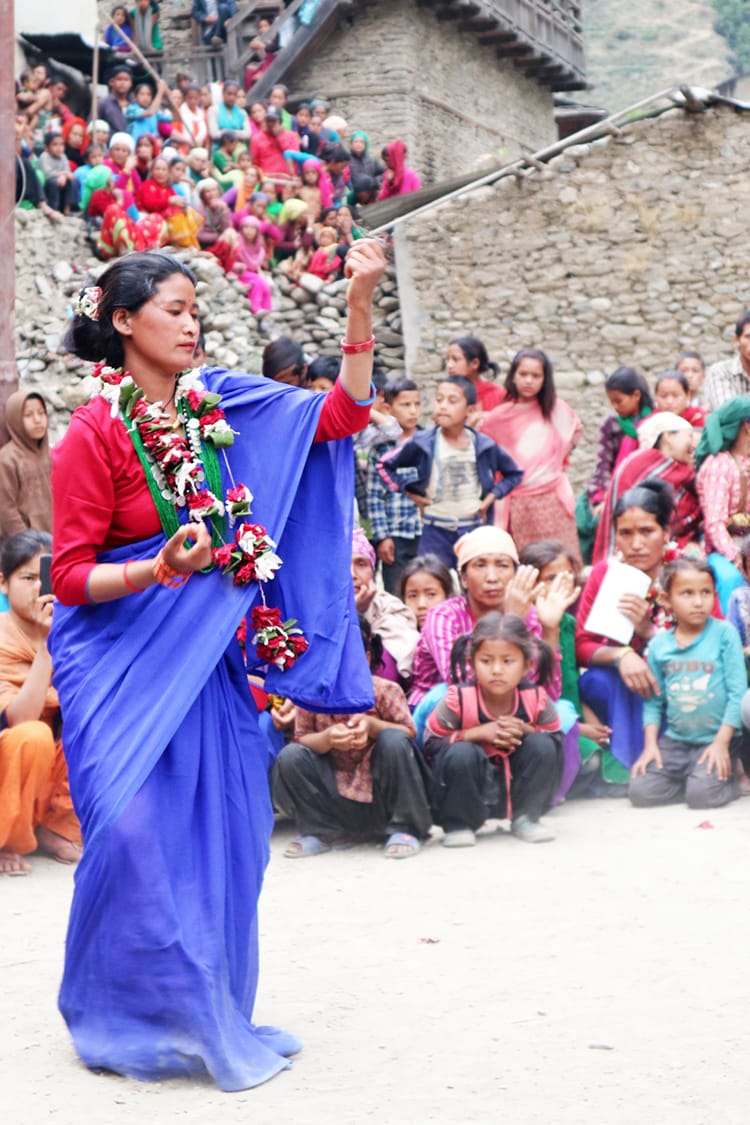
Last year, I was visiting my boyfriend’s village with him when a sweet old woman declared confidently in Nepali that, “White girls come to Nepal to dance!” My boyfriend asked why she thought that, and we realized quickly what she meant. A tour company had arranged an “authentic” trip to her village with an “authentic” dance from the villagers included in the brochure. Of course, the villagers don’t just dance every night, so they had been told to dance that night for the tourists. What resulted was this sweet old woman believing that tourists came to Nepal to dance. The three white girls who visited her village were proof. As I walked around the circle focusing on my steps, all I could think was how “White girls came to dance.” I laughed off my embarrassment and decided to go with the flow. One dance led to the next, and when I looked up, a few of the men had joined me followed by giggles from the audience.
The next dancers came out wearing peacock inspired outfits. They were dancing in pairs and the boy and girls each held sticks. They had metal rings on their feet that sounded like rain when they stomped or moved. “Nepali tap dancing,” I thought to myself. They banged the sticks in rhythm, creating a unique sound of rain and thunder. Suddenly, a masked man dressed as a woman came out and began taunting the audience. He was obviously a very naughty character. He wiggled his butt and danced mischievously around the inside of the circle making the locals smile and laugh. When I pointed my camera at him, he played into it soaking in the spotlight.
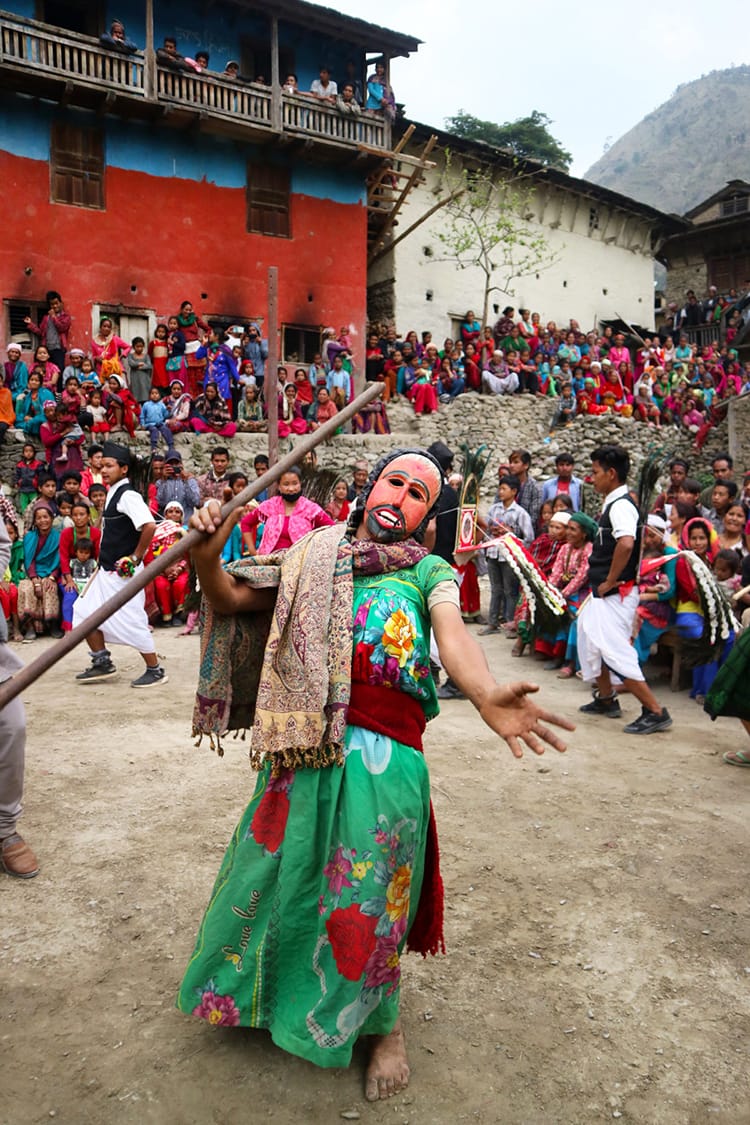
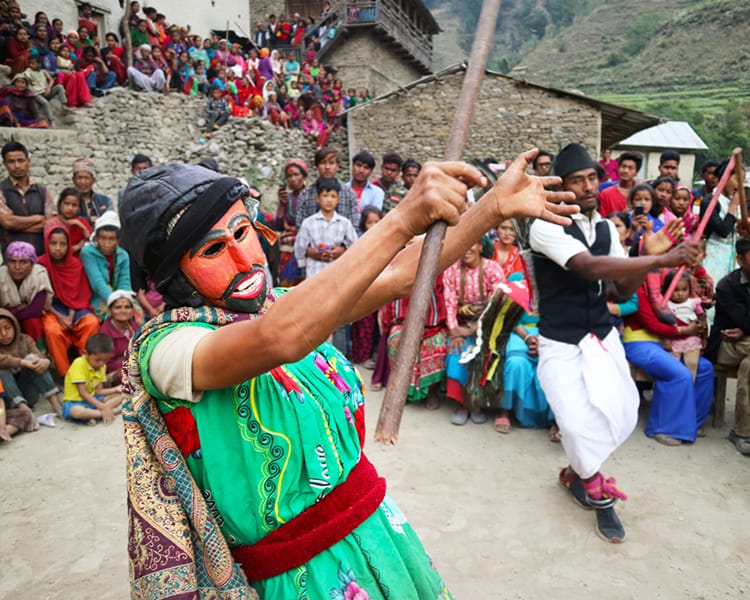
Soon the dances ended and the sky darkened. A demonstration was done to show the representatives how the chlorine makers worked, and each one was proudly handed their own to take back to their village with them. As the day began to wind down, I could feel the weight of the flowers around my neck. I saw a little girl dressed in rags across the square and began to talk to her in Nepali. I took off one of my many malas and hung it over her neck while telling her she was beautiful. Soon, I had a herd of little girls around me, and I began to distribute the flowers to them. Little boys began to approach me, and I gave them some as well. I took their photos and showed them the images which resulted in laughter and the word “Photo! Photo!” being yelled by every child who wanted to have a turn.
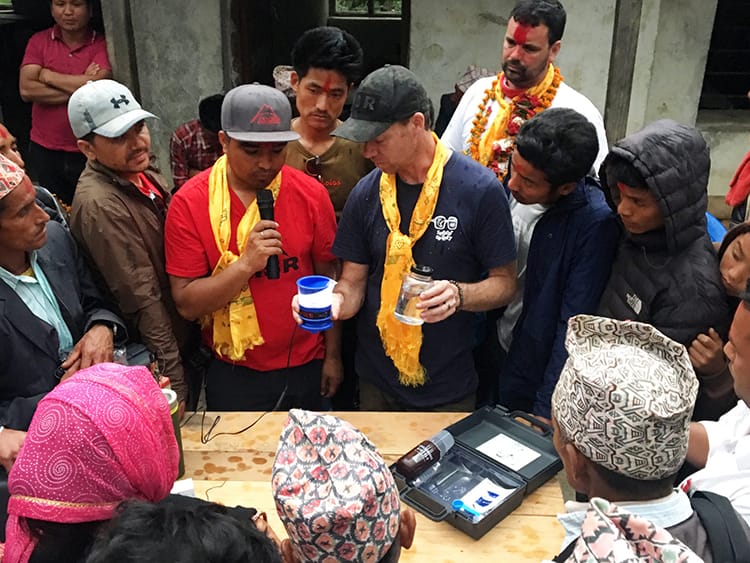
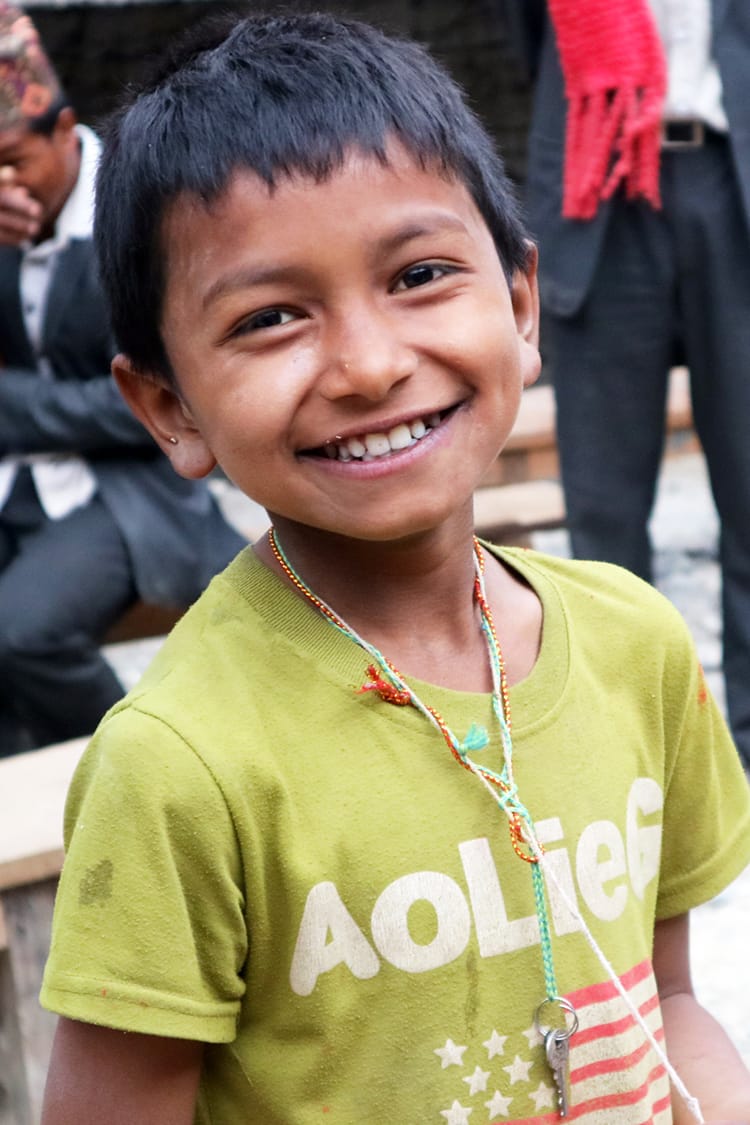

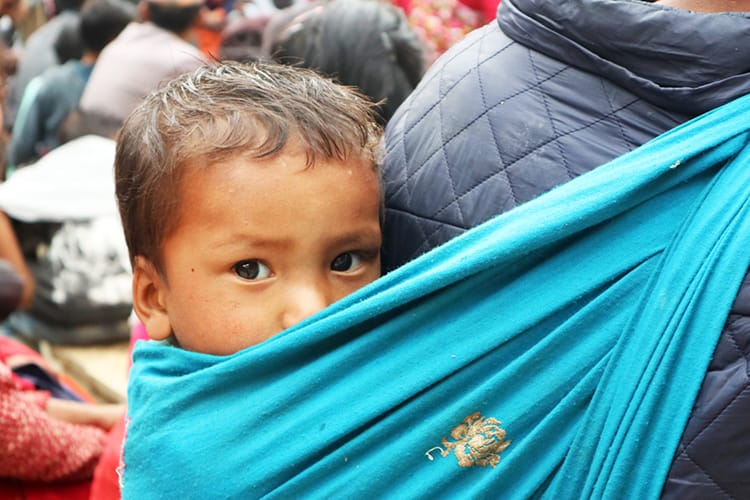
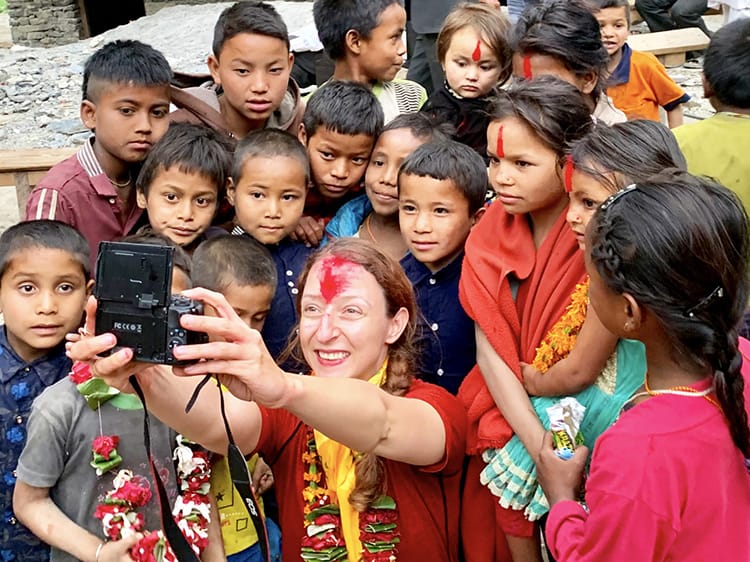
It started to drizzle as we headed back to camp for dinner. On the way, we were invited into a local’s home for a feast of mutton. We sat in the living room reminiscing over the day’s festivities. None of it had been planned by our guide or by Clean Drink Adventures. The villagers had planned it all on their own as a surprise. It was from the heart. A genuine travel moment few ever get to experience. I sat there feeling so grateful and lucky to have seen something so rare and sweet. After dinner we were served dessert with a side of the famous honey hunter honey. We added it to yogurt and onto chapatis. Each of us relished it, repeating over and over how it was the best honey we’d ever tasted.
It was late and time for bed, but it was still pouring rain outside. I’d packed poorly for the situation and found myself without a sleeping bag. I intended to buy blankets that afternoon in town, but the unexpected festivities had consumed the entire day. The two young girls who lived in the house invited me for a sleepover, worried I’d freeze in the tent. We snuggled up in blankets and talked in simple Nepali phrases before bed. They spoke slowly and exaggerated the words so that I could understand.
“What country are you from?”
“I’m from America. What country are you from?” They giggled, the answer clearly Nepal.
“What city are you from?”
“New York.”
“How old are you.”
“Three Zero.” I didn’t know the word for thirty.
“Do you like Nepal?”
“I like Nepal a lot.”
The next question brought on a lot of giggles. “Do you have a boyfriend?”
“Yes, in Kathmandu.” More giggles. The conversation continued until we all fell asleep.
In the morning, they walked me back to camp for breakfast. We packed up all of our belongings, sad to leave Kaina Bazaar so soon. The time had come too quickly. Our crew walked back to the main village, and as we turned the corner, the sound of drums hit our ears. There they were, 200 plus villagers ready to see us off with the accompaniment of the famous drums. We stood in a line as people approached us with flower garlands and red tikka, some of which I still hadn’t washed off from the day before. One of the village leaders approached us with a large bag full of jars of honey. A departing gift since we enjoyed it so much for dessert.
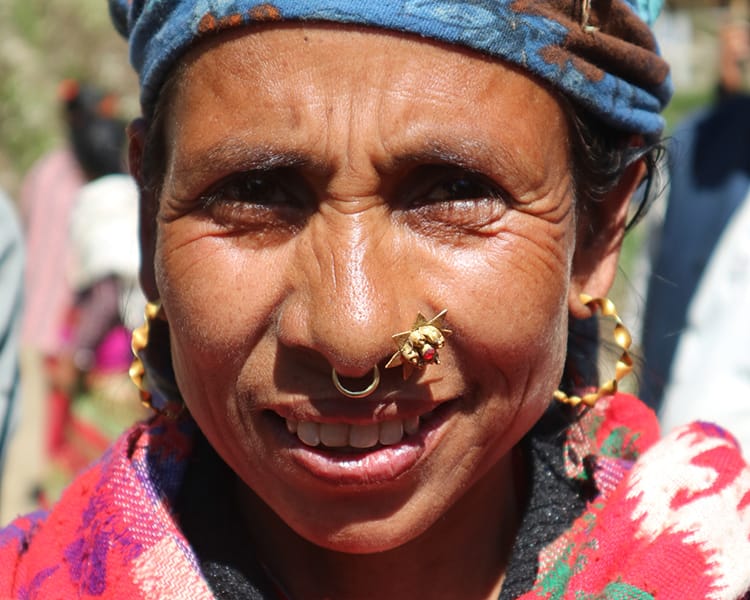
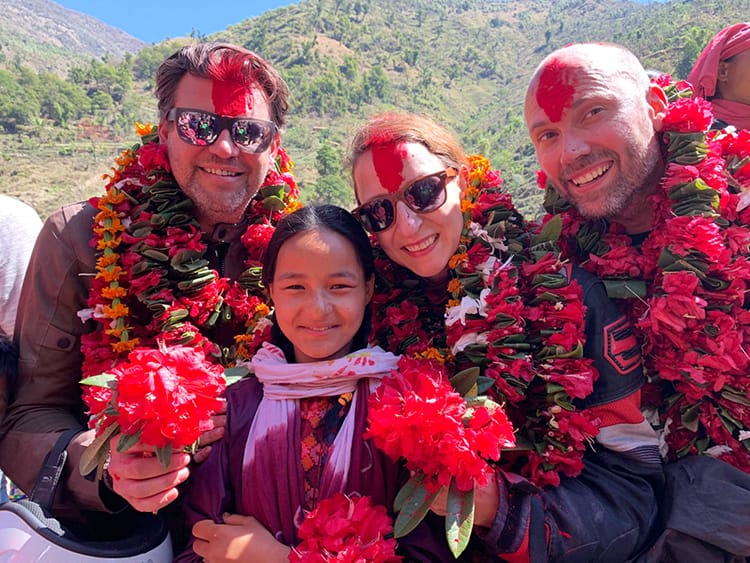
A woman I had photographed the day before held my elbows, and I linked my arms to hold onto hers. She leaned forward into me, our foreheads touching. After a long pause, she raised her head back up, a smile on her face that radiated through her eyes. Language is a funny thing. Had she spoken Nepali, I might have understood her, but for this moment there was no word that fit. Just a feeling we both shared. Something of gratitude towards each other and a mutual respect shared between two women. She let go of my hands just before I hopped onto the back of the motorcycle.
I waved to the young girls I’d spent time with and handed two of them the rhododendron flowers someone had given to me. We drove down the hill, slowly following the drum line that led the way. Marigolds and red florets trailed behind us leaving a breadcrumb trail of flowers in our trace.
Special thanks to everyone who donated to my campaign including several anonymous donors. This celebration was for each and every one of you!
Carol Della Giovanna, Nicole Gargiulo, Suraj Pradhan, Jennifer Daniels, Jessi Hall, Deborah Merrick, Selina Schwaiger, Sheryl Rivard, Gary Spears, Dylan Gallagher, Chris Bennet, Sharmaine Sottile, Julie Wagner, Kelsey Rushing, Julia Bebel, Fae Niyu, Clerbie Montilus, Judy Janda Tibbetts, Vanessa Branco, Roobens Fils, Stuart Kavanagh, Christina Fontaness, Edel Fenelon, Lisa Deyo, Annalee Cunningham, Lene Madsen, Arryon Bryan, and Penny Tweedie
Visit the Far Xplore page if you’d like to go on one of their trips or if you’d like to donate to their ongoing efforts!
You might also like…

Michelle Della Giovanna
Writer at Full Time Explorer
I’m just your average New Yorker who quit her job in the fashion industry to explore the world. Come find out what it’s like to trade in five-inch heels for squat toilets.
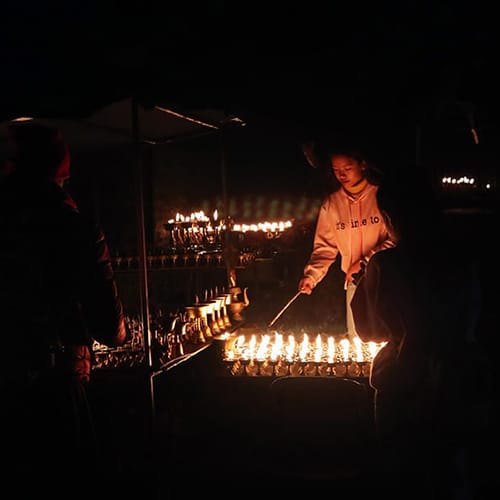
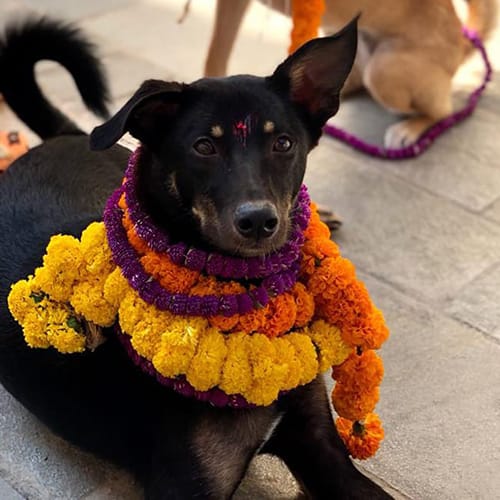
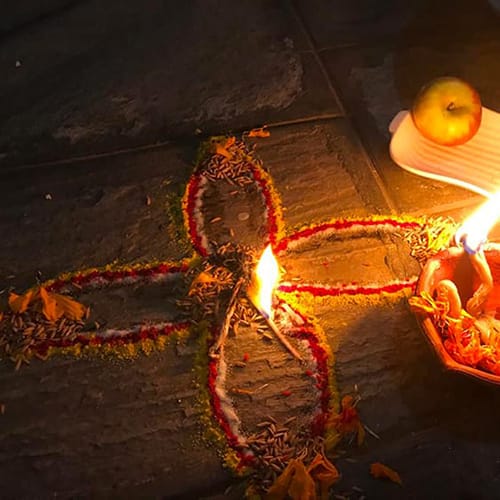
Leave a Reply